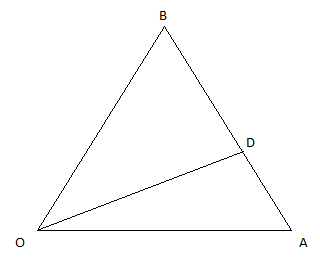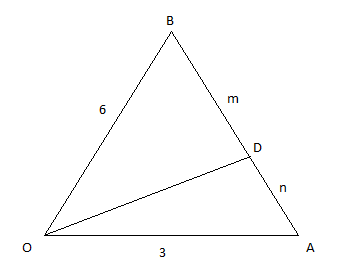
The position vectors of the points A and B with respect to O are 2i+2j+k and 2i+4j+4k. The length of the internal bisector of
A.\[\sqrt {\dfrac{{136}}{9}} \]
B. \[\sqrt {\dfrac{{136}}{3}} \]
C. \[\dfrac{{20}}{3}\]
D. \[\sqrt {\dfrac{{217}}{9}} \]
E. \[\dfrac{{25}}{3}\]
Answer
216.6k+ views
Hint: If a is any position vector, then the magnitude of that vector can be determined by using formula. Also we can find the point that divides any line by section formula.
Formula used:
Let a be any position vector,
\[a = {a_1}i + {b_1}j + {c_1}k\]
\[\left| {\overrightarrow a } \right| = \sqrt {{a_1}^2 + {b_1}^2 + {c_1}^2} \]
Where i is unit vector along x-axis, j is unit vector along y-axis and z is unit vector along z-axis.
\[\left| {\overrightarrow a } \right|\] is the magnitude of position vector \[\overrightarrow a \]
If P is the point that divides the line \[({x_1},{y_1})\,{\rm{ and }}\,({x_2},{y_2}){\rm{ }}\], then section formula ,
\[\begin{array}{l}P(x,y) = (\dfrac{{m{x_2}{\rm{ + n}}{{\rm{x}}_1}}}{{m + n}},\dfrac{{m{y_2}{\rm{ + n}}{{\rm{y}}_1}}}{{m + n}})\\\end{array}\]
Where m and n are defined the division of the line segment into a ratio m:n.
Complete step by step solution:

Image: side AB divided in ratio 2:1
Position vector of OA and OB is given, we find the magnitude
\[\overrightarrow {OA} = 2i + 2j + k\]
\[\begin{array}{l}\left| {\overrightarrow {OA} } \right| = \sqrt {{2^2} + {2^2} + {1^2}} \\ \Rightarrow \left| {\overrightarrow {OA} } \right|{\rm{ = }}\sqrt {4 + 4 + 1} \\ \Rightarrow \left| {\overrightarrow {OA} } \right|{\rm{ = }}\sqrt 9 \\{\rm{ = 3}}\end{array}\]
Also, \[\overrightarrow {OB} = 2i + 4j + 4k\]
\[\begin{array}{l}\left| {\overrightarrow {OB} } \right| = \sqrt {{2^2} + {4^2} + {4^2}} \\ \Rightarrow \left| {\overrightarrow {OB} } \right|{\rm{ = }}\sqrt {4 + 16 + 16} \\ \Rightarrow \left| {\overrightarrow {OB} } \right|{\rm{ = }}\sqrt {36} \\ \Rightarrow \left| {\overrightarrow {OB} } \right|{\rm{ = 6}}\end{array}\]
The length OD(in figure) of the internal bisector of divided the line AB as m:n =2:1by angle bisector rule,

Image: side AB divided in ratio 2:1
As, \[{\rm{ }}\dfrac{m}{n} = \dfrac{{OA}}{{OB}} = \dfrac{3}{6} = \dfrac{1}{2}\]
By section formula,
\[\begin{array}{l}\overrightarrow {OD} = \dfrac{{m \times \overrightarrow {OB} {\rm{ + n}} \times \overrightarrow {OA} }}{{m + n}}\\\end{array}\]
Substituting the values, we get
\[\overrightarrow {OD} = 2i + \dfrac{8}{3}j + 2k\]
Magnitude of this position vector is
\[\begin{array}{l}\left| {\overrightarrow {OD} } \right| = \sqrt {{2^2} + {{\dfrac{8}{3}}^2} + {2^2}} \\ \Rightarrow \left| {\overrightarrow {OD} } \right|{\rm{ = }}\sqrt {4 + \dfrac{{64}}{9} + 4} \\ \therefore \left| {\overrightarrow {OD} } \right|{\rm{ = }}\sqrt {\dfrac{{136}}{9}} \\\end{array}\]
Therefore the length of internal bisector OD is \[\sqrt {\dfrac{{136}}{9}}\].
Hence, option A is the correct answer.
Note:In kinematics, the position vector specifies the position of a body. It gives the position or the location of any given point with respect to any reference point like origin in general. The change in the position vector of a body is known as the displacement vector. It is also defined as the vector distance between the initial point and the final point.
Formula used:
Let a be any position vector,
\[a = {a_1}i + {b_1}j + {c_1}k\]
\[\left| {\overrightarrow a } \right| = \sqrt {{a_1}^2 + {b_1}^2 + {c_1}^2} \]
Where i is unit vector along x-axis, j is unit vector along y-axis and z is unit vector along z-axis.
\[\left| {\overrightarrow a } \right|\] is the magnitude of position vector \[\overrightarrow a \]
If P is the point that divides the line \[({x_1},{y_1})\,{\rm{ and }}\,({x_2},{y_2}){\rm{ }}\], then section formula ,
\[\begin{array}{l}P(x,y) = (\dfrac{{m{x_2}{\rm{ + n}}{{\rm{x}}_1}}}{{m + n}},\dfrac{{m{y_2}{\rm{ + n}}{{\rm{y}}_1}}}{{m + n}})\\\end{array}\]
Where m and n are defined the division of the line segment into a ratio m:n.
Complete step by step solution:

Image: side AB divided in ratio 2:1
Position vector of OA and OB is given, we find the magnitude
\[\overrightarrow {OA} = 2i + 2j + k\]
\[\begin{array}{l}\left| {\overrightarrow {OA} } \right| = \sqrt {{2^2} + {2^2} + {1^2}} \\ \Rightarrow \left| {\overrightarrow {OA} } \right|{\rm{ = }}\sqrt {4 + 4 + 1} \\ \Rightarrow \left| {\overrightarrow {OA} } \right|{\rm{ = }}\sqrt 9 \\{\rm{ = 3}}\end{array}\]
Also, \[\overrightarrow {OB} = 2i + 4j + 4k\]
\[\begin{array}{l}\left| {\overrightarrow {OB} } \right| = \sqrt {{2^2} + {4^2} + {4^2}} \\ \Rightarrow \left| {\overrightarrow {OB} } \right|{\rm{ = }}\sqrt {4 + 16 + 16} \\ \Rightarrow \left| {\overrightarrow {OB} } \right|{\rm{ = }}\sqrt {36} \\ \Rightarrow \left| {\overrightarrow {OB} } \right|{\rm{ = 6}}\end{array}\]
The length OD(in figure) of the internal bisector of divided the line AB as m:n =2:1by angle bisector rule,

Image: side AB divided in ratio 2:1
As, \[{\rm{ }}\dfrac{m}{n} = \dfrac{{OA}}{{OB}} = \dfrac{3}{6} = \dfrac{1}{2}\]
By section formula,
\[\begin{array}{l}\overrightarrow {OD} = \dfrac{{m \times \overrightarrow {OB} {\rm{ + n}} \times \overrightarrow {OA} }}{{m + n}}\\\end{array}\]
Substituting the values, we get
\[\overrightarrow {OD} = 2i + \dfrac{8}{3}j + 2k\]
Magnitude of this position vector is
\[\begin{array}{l}\left| {\overrightarrow {OD} } \right| = \sqrt {{2^2} + {{\dfrac{8}{3}}^2} + {2^2}} \\ \Rightarrow \left| {\overrightarrow {OD} } \right|{\rm{ = }}\sqrt {4 + \dfrac{{64}}{9} + 4} \\ \therefore \left| {\overrightarrow {OD} } \right|{\rm{ = }}\sqrt {\dfrac{{136}}{9}} \\\end{array}\]
Therefore the length of internal bisector OD is \[\sqrt {\dfrac{{136}}{9}}\].
Hence, option A is the correct answer.
Note:In kinematics, the position vector specifies the position of a body. It gives the position or the location of any given point with respect to any reference point like origin in general. The change in the position vector of a body is known as the displacement vector. It is also defined as the vector distance between the initial point and the final point.
Recently Updated Pages
JEE Atomic Structure and Chemical Bonding important Concepts and Tips

JEE Amino Acids and Peptides Important Concepts and Tips for Exam Preparation

Electricity and Magnetism Explained: Key Concepts & Applications

Chemical Properties of Hydrogen - Important Concepts for JEE Exam Preparation

JEE Energetics Important Concepts and Tips for Exam Preparation

JEE Isolation, Preparation and Properties of Non-metals Important Concepts and Tips for Exam Preparation

Trending doubts
JEE Main 2026: Application Form Open, Exam Dates, Syllabus, Eligibility & Question Papers

Derivation of Equation of Trajectory Explained for Students

Hybridisation in Chemistry – Concept, Types & Applications

Understanding the Angle of Deviation in a Prism

Understanding Collisions: Types and Examples for Students

How to Convert a Galvanometer into an Ammeter or Voltmeter

Other Pages
JEE Advanced Marks vs Ranks 2025: Understanding Category-wise Qualifying Marks and Previous Year Cut-offs

Units And Measurements Class 11 Physics Chapter 1 CBSE Notes - 2025-26

NCERT Solutions For Class 11 Physics Chapter 8 Mechanical Properties Of Solids

Motion in a Straight Line Class 11 Physics Chapter 2 CBSE Notes - 2025-26

NCERT Solutions for Class 11 Physics Chapter 7 Gravitation 2025-26

Ideal and Non-Ideal Solutions Explained for Class 12 Chemistry




